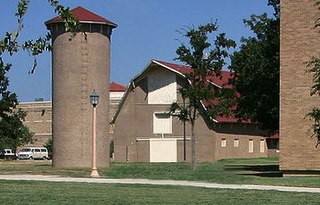Related Research Articles

The National Telecommunications and Information Administration (NTIA) is an agency of the United States Department of Commerce that serves as the President's principal adviser on telecommunications policies pertaining to the United States' economic and technological advancement and to regulation of the telecommunications industry.

King Mongkut's Institute of Technology Ladkrabang is a research and educational institution in Thailand. It is situated in Lat Krabang District, Bangkok approximately 30 km east of the city center. The university consists of nine faculties: engineering, architecture, science, industrial education and technology, agricultural technology, information technology, food industry, liberal arts, and medicine.
Executive education refers to academic programs at graduate-level business schools for executives, business leaders and functional managers globally. These programs are generally non-credit and non-degree-granting, but sometimes lead to certificates and some offer continuing education units accepted by professional bodies and institutes. Estimates by Business Week magazine suggest that executive education in the United States is approximately an $800 million annual business with approximately 80% provided by university-based business schools. Many traditionally upper tier schools offer these programs as well as business schools and other academic institutions.

The Elementary and Secondary Education Act (ESEA) was passed by the 89th United States Congress and signed into law by President Lyndon B. Johnson on April 11, 1965. Part of Johnson's "War on Poverty", the act has been one of the most far-reaching pieces of federal legislation affecting education ever passed by the United States Congress, and was further emphasized and reinvented by its modern, revised No Child Left Behind Act.
The School of Education and Human Development is a public school of education in the United States, on the campus of the University of Virginia in Charlottesville. The School of Education and Human Development offers professional programs designed to prepare individuals for a variety of careers related to the practice of education. The current Dean of the School of Education and Human Development is Stephanie J. Rowley.

WETA-TV is the primary PBS member television station in Washington, D.C. Owned by the Greater Washington Educational Telecommunications Association, it is a sister station to NPR member WETA. The two outlets share studios in nearby Arlington County, Virginia; WETA-TV's transmitter is located in the Tenleytown neighborhood in Northwest Washington.

Agricultural education is the teaching of agriculture, natural resources, and land management. At higher levels, agricultural education is primarily undertaken to prepare students for employment in the agricultural sector. Classes taught in an agricultural education curriculum may include horticulture, land management, turf grass management, agricultural science, small animal care, machine and shop classes, health and nutrition, livestock management, and biology.
Dakota County Technical College (DCTC) is a public, two-year technical college in Rosemount, Minnesota, United States. It is located in Dakota County inside the Minneapolis/St. Paul metropolitan area. DCTC belongs to the Minnesota State Colleges and Universities System and is one of five stand-alone technical colleges in the state.

Universitas Terbuka is Indonesia state university and employs open and distance learning (ODL) system to widen access to higher education to all Indonesian citizens, including those who live in remote islands throughout the country, as well as in various parts of the world. It has a total student body of 1,045,665 as of 2019/2020 according to Indonesia's Ministry of Education and Culture Higher Education database. According to a distance education institution in the UK, which published "The Top Ten Mega Universities", UT-3 ranks closely with universities from China and Turkey.

The San Diego Community College District (SDCCD) is a public community college district in San Diego, California. The SDCCD is one of the five community college districts in San Diego County and part of the California Community Colleges system. Under the California Master Plan for Higher Education, the California Community Colleges system is a part of the state's three-tier public higher education system, which also includes the University of California system and California State University system.

The University of Florida Institute of Food and Agricultural Sciences (UF/IFAS) is a teaching, research and Extension scientific organization focused on agriculture and natural resources. It is a partnership of federal, state, and county governments that includes an Extension office in each of Florida's 67 counties, 12 off-campus research and education centers, five demonstration units, the University of Florida College of Agricultural and Life Sciences, three 4-H camps, portions of the UF College of Veterinary Medicine, the Florida Sea Grant program, the Emerging Pathogens Institute, the UF Water Institute and the UF Genetics Institute.

Georgetown University School of Medicine, a medical school opened in 1851, is one of Georgetown University's five graduate schools. It is located on Reservoir Road in the Georgetown neighborhood of Washington, DC, adjacent to the University's main campus. The School of Medicine works in association with the 609-bed MedStar Georgetown University Hospital, MedStar Washington Hospital Center, and nine other affiliated federal and community hospitals in the Washington metropolitan area. Georgetown is the oldest Catholic medical school in the United States.
Title 20 of the United States Code outlines the role of education in the United States Code.

The Internet in the United States grew out of the ARPANET, a network sponsored by the Advanced Research Projects Agency of the U.S. Department of Defense during the 1960s. The Internet in the United States in turn provided the foundation for the worldwide Internet of today.
A business–education partnership is an agreement of collaboration between schools and businesses, unions, governments or community organizations. These partnerships are established by agreement between two or more parties to establish goals, and to construct a plan of action for achievement of those goals.
The America Creating Opportunities to Meaningfully Promote Excellence in Technology, Education, and Science Act of 2007, or America COMPETES Act, was authored by Bart Gordon, and became law on August 9, 2007, when it was signed by President George W. Bush. This was an act "[t]o invest in innovation through research and development, and to improve the competitiveness of the United States".
Race to the Top was a $4.35 billion United States Department of Education competitive grant created to spur and reward innovation and reforms in state and local district K–12 education. Funded as part of the American Recovery and Reinvestment Act of 2009, it was announced by President Barack Obama and Secretary of Education Arne Duncan on July 24, 2009. States competing for the grants were awarded points for enacting certain educational policies, instituting performance-based evaluations for teachers and principals based on multiple measures of educator effectiveness, adopting common standards, adopting policies that did not prohibit the expansion of high-quality charter schools, turning around the lowest-performing schools, and building and using data systems.

Partners in Development Foundation (PIDF), an IRS Section 501(c)(3) non-profit public foundation, was incorporated in 1997 in Honolulu, Hawaiʻi. It has established and implemented programs in the areas of education, social services, Hawaiian culture, Hawaiian language, and preservation of the natural environment and traditional Hawaiian agriculture. These programs now have served close to ten thousand people in communities throughout Hawai‘i. In 2011, PIDF received grants of more than $1.6 million from the US Department of Education through the Native Hawaiian Education Act. The grants were awarded for the purpose of continuing, expanding, and improving the educational programs of PIDF.
Information Communications Technology is usually included in the Home Economics and Livelihood Education program in grade school and taught through the Technology and Home Economics program in high school. The recent status of ICT education in the Philippines, along with other Southeast Asian countries, was surveyed by the Southeast Asian Ministers of Education Organization (SEAMEO) in 2011. Using the UNESCO model of ICT Development in Education, the countries were ranked as Emerging, Applying, Infusing or Transforming. The Philippines were ranked at the Infusing stage of integrating ICT in education, indicating that the country has integrated ICT into existing teaching, learning and administrative practices and policies. This includes components such as a national vision of ICT in education, national ICT plans and policies, complementary national ICT and education policies, professional development for teachers and school leaders, community or partnership and teaching and learning pedagogies. A 2012 study reported that public high schools in Metro Manila had a computer to student ratio of 1:63. While 88 percent of schools have internet connections, half of the students claimed not to be using it.

The Education for Economic Security Act is a United States federal education law that was enacted in 1984. It provided funding for programs to support schools and teachers in the instruction of math and science, including grants, awards, and scholarships. The act funded teacher training programs and awarded schools and teachers that excelled in the instruction of math and science. The act also developed a program to combat asbestos in schools, fund magnet schools, and protect students from religious discrimination.
References
- ↑ West, Peter (29 November 1989). "Recipients of Star Schools Grants Seeking New Funding To Continue - Education Week". Education Week.